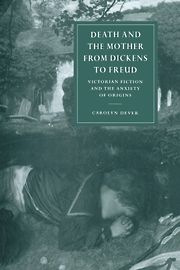Book contents
- Frontmatter
- Contents
- Preface
- 1 The lady vanishes
- 2 Psychoanalytic cannibalism
- 3 Broken mirror, broken words: Bleak House
- 4 Wilkie Collins and the secret of the mother's plot
- 5 Denial, displacement, Deronda
- 6 Calling Dr. Darwin
- 7 Virginia Woolf's “Victorian novel”
- Notes
- Index
- CAMBRIDGE STUDIES IN NINETEENTH-CENTURY LITERATURE AND CULTURE
3 - Broken mirror, broken words: Bleak House
Published online by Cambridge University Press: 09 November 2009
- Frontmatter
- Contents
- Preface
- 1 The lady vanishes
- 2 Psychoanalytic cannibalism
- 3 Broken mirror, broken words: Bleak House
- 4 Wilkie Collins and the secret of the mother's plot
- 5 Denial, displacement, Deronda
- 6 Calling Dr. Darwin
- 7 Virginia Woolf's “Victorian novel”
- Notes
- Index
- CAMBRIDGE STUDIES IN NINETEENTH-CENTURY LITERATURE AND CULTURE
Summary
Is autobiography somehow always in the process of symbolically killing the mother off by telling her the lie that we have given birth to ourselves?
Barbara JohnsonOur topic deals with the giving and taking away of faces, with face and deface, figure, figuration and disfiguration.
Paul de ManIn Dickens's Bleak House (1852–3), generic conventions of domestic novel, detective novel, and autobiography collide in the narrative of Esther Summerson, whose quest for identity is structured through her desire to reunite with her missing, mysterious mother. In fact, Esther “loses” her mother a total of three times in the course of the novel; these “deaths” provide both the structuring principle and the central crisis of Esther's fictional autobiography. In this chapter, I will argue that each of these moments presents the conditions of “loss” in different terms, and that each time, Esther is increasingly confronted with the question of her own implication in her abandonment. The extent to which she consents to and even comes to desire loss is directly proportional to her ability to master the terms of the autobiographical narrative. In other words, Esther's ability to represent herself as a subject, as an agent, is dependent on her status as a mourner; there is a direct relationship between abandonment and articulation, and specifically, between the death of a mother and the birth of an authorial subject.
- Type
- Chapter
- Information
- Death and the Mother from Dickens to FreudVictorian Fiction and the Anxiety of Origins, pp. 81 - 106Publisher: Cambridge University PressPrint publication year: 1998

